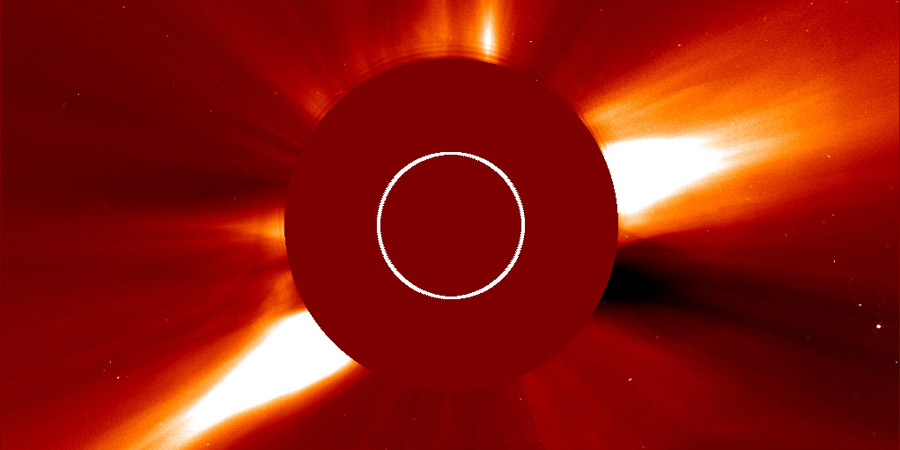M3.7 coronal mass ejection
Thursday, 5 November 2015 01:06 UTC

Yesterday at 13:52 UTC, a long duration M3.7 (R1-minor) solar flare took place near sunspot region 2443. It released a coronal mass ejection that will likely arrive at our planet during the evening hours on Saturday, 7 November.
For more information be sure to read our previous news article.
A very decent coronal mass ejection was expected from this event as this was a long duration solar flare. SDO showed coronal dimming and NOAA directly reported IV and II radio sweeps. Now that we have enough SOHO LASCO coronagraph imagery we have to conclude that the coronal mass ejection isn't as impressive as we expected.


Animations: SOHO LASCO C2 and C3 coronagraph imagery showing the CME released by the M3.7 solar flare.
A rather faint coronal mass ejection emerged following the solar flare. Most of the ejecta looks to be heading southwest of the ecliptic but there is an earth-directed component. CACtus only gives us a speed of about 500km/s for this coronal mass ejection which isn't much faster than the ambient solar wind. We do not expect a major impact but high latitude sky watchers should be alert for aurora when the plasma cloud arrives. Impact time for this coronal mass ejection considering the speed of this coronal mass ejection should be in the evening (UTC timezone) hours of Saturday 7 November 2015 which we calculated by using the Drag-Based Model. Minor G1 geomagnetic storming conditions are expected at most.
Coronal hole solar wind stream
We should note that a solar wind stream from a southern extension of the northern hemisphere polar coronal hole could become geo-effective after the arrival of this coronal mass ejection, possibly on Sunday 8 November or Monday 9 November. Be sure to follow us on Twitter if you immediately wish to be notified once the coronal hole faces Earth.
Thank you for reading this article! Did you have any trouble with the technical terms used in this article? Our help section is the place to be where you can find in-depth articles, a FAQ and a list with common abbreviations. Still puzzled? Just post on our forum where we will help you the best we can!
Latest news
Latest forum messages
Support SpaceWeatherLive.com!
A lot of people come to SpaceWeatherLive to follow the Solar activity or if there is a chance to see the aurora, but with more traffic comes higher costs to keep the servers online. If you like SpaceWeatherLive and want to support the project you can choose a subscription for an ad-free site or consider a donation. With your help we can keep SpaceWeatherLive online!
Space weather facts
| Last X-flare | 2025/12/08 | X1.1 |
| Last M-flare | 2025/12/21 | M1.3 |
| Last geomagnetic storm | 2025/12/22 | Kp5 (G1) |
| Spotless days | |
|---|---|
| Last spotless day | 2022/06/08 |
| Monthly mean Sunspot Number | |
|---|---|
| November 2025 | 91.8 -22.8 |
| December 2025 | 115.2 +23.4 |
| Last 30 days | 109.1 +22.6 |





